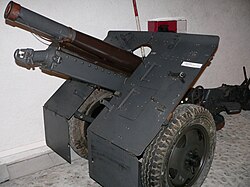| Bofors 75mm Model 1934 | |
|---|---|
 Swiss 7.5 cm L\24 mountain gun M1933/48 | |
| Type | Mountain gun |
| Place of origin |
|
| Service history | |
| Used by |
|
| Wars | World War II |
| Production history | |
| Designer | Bofors |
| Manufacturer | Bofors |
| Specifications | |
| Mass | 928 kg (2,046 lb) |
| Barrel length | 1.8 m (5 ft 11 in) L/24 |
|
| |
| Shell | 6.59 kg (14.5 lb) |
| Caliber | 75 millimetres (3.0 in) |
| Carriage | box trail |
| Elevation |
-4° to +56° (long carriage) -10° to +50° (short carriage) |
| Traverse | 7° 54' |
| Muzzle velocity | 455 m/s (1,490 ft/s) |
| Effective firing range | 9,300 m (10,200 yd) |
The Bofors 75 mm Model 1934 was a mountain gun produced in Sweden by Bofors and sold abroad widely. The Model 1934 was used by Germany, Belgium, The Netherlands and China in World War II. Germany bought a small number of guns (12)[citation needed] for evaluation and training before the war and designated them as the 7.5 cm Gebirgshaubitze 34. Belgian guns, known by them as the Canon de 75 mle 1934, captured by Germany were designated as 7.5 cm Gebirgskanone 228(b). The later model 1936 was purchased by Bulgaria.
Design[]
The Netherlands purchased a pack loadable version for their colonial-army in the Dutch East Indies, a region covered by thick forests and mountains. The pack loadable version could be broken down into eight mule loads or towed by a four horse team, with a further six mules to carry ammunition and other supplies. The Dutch guns were used briefly during the Dutch East Indies campaign in 1941-42.
The model purchase by Belgium was not a pack gun and was equipped for towing by motor transport. The Belgian model had a one-piece box-trail that was hinged to fold upwards to reduce towing length and was equipped with steel disc wheels with rubber tires.[1]
Sources differ on specifications, but data from Gander & Chamberlain is presumed to be more accurate and is presented above.
References[]
- Chamberlain, Peter & Gander, Terry. Infantry, Mountain and Airborne Guns. New York, Arco
- Gander, Terry and Chamberlain, Peter. Weapons of the Third Reich: An Encyclopedic Survey of All Small Arms, Artillery and Special Weapons of the German Land Forces 1939-1945. New York: Doubleday, 1979 ISBN 0-385-15090-3
- Bishop, Chris, ed. Encyclopedia of Weapons of World War II. New York, Barnes and Noble, 1998 ISBN 0-7607-1022-8
Notes[]
- ↑ Encyclopedia of Weapons of World War II
| ||||||||||||||||||||||||||||||||
| |||||||||||||||||||||||||||||||||||||||||||||||||||||||||||
The original article can be found at Bofors 75 mm Model 1934 and the edit history here.